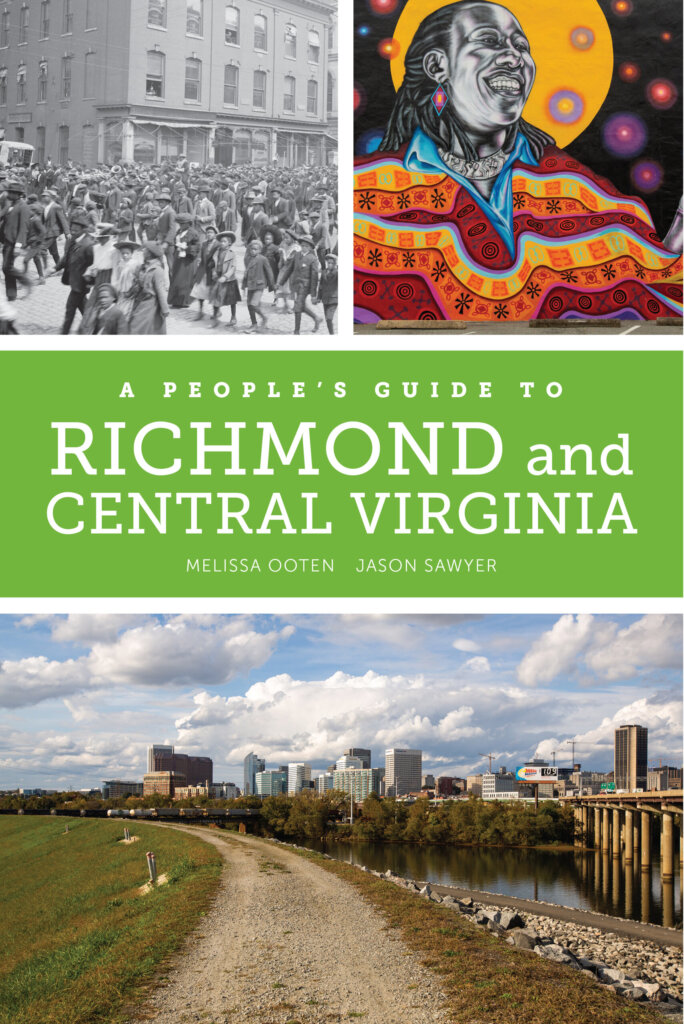by Melissa Ooten and Jason Sawyer


The author team of Melissa Ooten and Jason Sawyer takes travelers out of our nation’s capital and into Richmond and Central Virginia, a historic epicenter of America’s racialized history. In A People’s Guide to Richmond and Central Virginia they counter the narrative that elites make history worth knowing by demonstrating how ordinary people come together to create more equitable futures.
Melissa Ooten directs a social justice leadership program and teaches in Women, Gender & Sexuality Studies at the University of Richmond.
Jason Sawyer is Assistant Professor of Human Services at Old Dominion University. His work centers community organizing, arts education, and transformative social justice work.
No neutral geographies exist. A People’s Guide to Richmond and Central Virginia exposes these contested histories in order to center the often unheard and unacknowledged people’s liberation movements at the spatial and ideological epicenter of past and ongoing resistance to settler colonization, the founding myths of the United States, and white supremacist nationalism. See the excerpt below from the introduction.
The guide connects the origins of the nation’s settler colonialism to contemporary contestations over white supremacy and connected socioeconomic and gender-based oppression that still shape the region, and the nation, today. It centers five themes that disrupt dominant narratives perpetuated in tourist material and corporate media while exposing vast gaps created by these widely disseminated sources.
The guide intentionally places narratives of resistance by Indigenous and Black communities at its forefront. Thus, the first theme accurately articulates the country’s founding as rooted in white colonization and settler colonialism, beginning with the first permanent English settlement at Jamestown. It includes resistance to campaigns of extermination aimed at Indigenous communities and the mass enslavement of Black people to provide labor that drove the country’s economy for centuries.
The second theme makes visible community efforts to dismantle the workings of white supremacy, including the disruption of Lost Cause nostalgia, an erroneously triumphant rendering of the confederacy as a heroic endeavor rather than one that sought to maintain enslavement by perpetuating racist institutions and belief systems.
A third theme showcases community resistance to government-planned destruction, especially of Black neighborhoods, and the concentration of poverty by design. It highlights people working, often against enormous odds, to rectify the impacts of redlining and highway building, the racial and geographic segregation of public housing, and repeated waves of gentrification.
Centering people organizing for environmental justice encompasses the guide’s fourth theme. These sites span rural and urban landscapes where people have mobilized against corporate greed and malfeasance in efforts to protect the health and long term welfare of communities, including on-going struggles against fossil fuel-carrying pipeline construction.
The final theme amplifies a homegrown artistic and cultural resurgence with deep roots in the region’s history of Black cultural production, the fostering of LGBTQ artists and activists, and the use of art to cultivate and sustain community. These sites exemplify contestations over artistic production that link to the broader power clashes, most of which use art and culture to provoke social change.
A People’s Guide to Richmond and Central Virginia integrates these five themes throughout the text in order to investigate sites of everyday life produced by, and deeply rooted in, past and present power struggles. Just as geographic dominance and spatial colonization shape our regional landscape, residents challenge and reshape those legacies of conquest and exploitation. Part of the work of this guide is to uncover what such dominance has worked to conceal, to ask how residents of Central Virginia occupy and contest space in order to reveal how they move through and construct meaning in the spaces of everyday life.
Part of the A People’s Guide Series
This post is part of our #2023ASA blog series. Visit our virtual ASA 2023 website and find out how to get 40% off our books.
